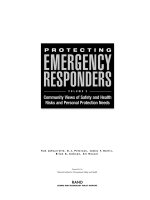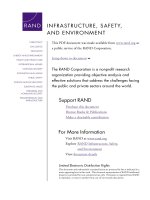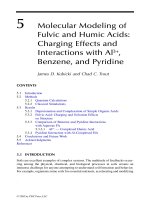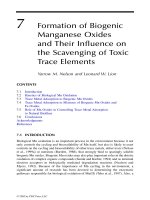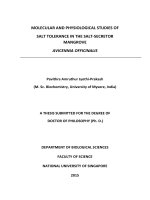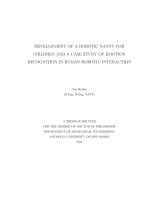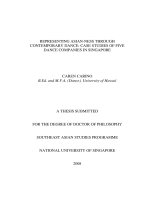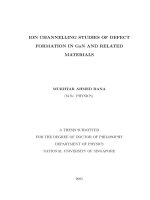Aptitude for Destruction, Volume 2 - Case Studies of Organizational Learning in Five Terrorist Groups pptx
Bạn đang xem bản rút gọn của tài liệu. Xem và tải ngay bản đầy đủ của tài liệu tại đây (904.43 KB, 216 trang )
This PDF document was made available from www.rand.org as
a public service of the RAND Corporation.
6
Jump down to document
Purchase this document
Browse Books & Publications
Make a charitable contribution
Visit RAND at www.rand.org
Explore RAND Infrastructure, Safety,
and Environment
View document details
This document and trademark(s) contained herein are protected by law as indicated in a
notice appearing later in this work. This electronic representation of RAND intellectual
property is provided for non-commercial use only. Permission is required from RAND
to reproduce, or reuse in another form, any of our research documents.
Limited Electronic Distribution Rights
For More Information
Support RAND
The RAND Corporation is a nonprofit research
organization providing objective analysis and
effective solutions that address the challenges facing
the public and private sectors around the world.
CHILD POLICY
CIVIL JUSTICE
EDUCATION
ENERGY AND ENVIRONMENT
HEALTH AND HEALTH CARE
INTERNATIONAL AFFAIRS
NATIONAL SECURITY
POPULATION AND AGING
PUBLIC SAFETY
SCIENCE AND TECHNOLOGY
SUBSTANCE ABUSE
TERRORISM AND
HOMELAND SECURITY
TRANSPORTATION AND
INFRASTRUCTURE
INFRASTRUCTURE, SAFETY,
AND ENVIRONMENT
This product is part of the RAND Corporation monograph series. RAND
monographs present major research findings that address the challenges facing
the public and private sectors. All RAND monographs undergo rigorous peer
review to ensure high standards for research quality and objectivity.
Aptitude for Destruction
Volume 2
Case Studies of Organizational Learning
in Five Terrorist Groups
Brian A. Jackson
John C. Baker
Kim Cragin
John Parachini
Horacio R. Trujillo
Peter Chalk
Prepared for the National Institute of Justice
The RAND Corporation is a nonprofit research organization providing
objective analysis and effective solutions that address the challenges facing
the public and private sectors around the world. RAND’s publications do
not necessarily reflect the opinions of its research clients and sponsors.
R
®
is a registered trademark.
© Copyright 2005 RAND Corporation
All rights reserved. No part of this book may be reproduced in any
form by any electronic or mechanical means (including photocopying,
recording, or information storage and retrieval) without permission in
writing from RAND.
Published 2005 by the RAND Corporation
1776 Main Street, P.O. Box 2138, Santa Monica, CA 90407-2138
1200 South Hayes Street, Arlington, VA 22202-5050
201 North Craig Street, Suite 202, Pittsburgh, PA 15213-1516
RAND URL: />To order RAND documents or to obtain additional information, contact
Distribution Services: Telephone: (310) 451-7002;
Fax: (310) 451-6915; Email:
Library of Congress Cataloging-in-Publication Data
Aptitude for destruction : organizational learning in terrorist groups and its implications for
combating terrorism / Brian A. Jackson [et al.]
.
p. cm.
“MG-331.”
Includes bibliographical references.
ISBN 0-8330-3764-1 (pbk. : alk. paper)
1. Terrorists. 2. Organizational learning. 3. Terrorism—Prevention—Government
policy. I. Jackson, Brian A. (Brian Anthony) II.Title.
HV6431.A67 2005
303.6'25—dc22
2005003983
“MG-332.”
ISBN 0-8330-3767-6
Photo courtesy of iStockphoto.com Inc. Copyright 2005 iStockphoto Inc.
Online at John Bohannon
Cover design by Stephen Bloodsworth
The research described in this report was supported by Grant No. 2003-
IJ-CX-1022 awarded by the National Institute of Justice, Office of Justice
Programs, U.S. Department of Justice. The research was conducted
within RAND Infrastructure, Safety, and Environment (ISE), a division
of the RAND Corporation, for the National Institute of Justice. Points
of view in this document are those of the authors and do not necessarily
represent the official position or policies of the U.S. Department of
Justice.
iii
Preface
Continuing conflicts between violent groups and states generate an ever-present de-
mand for higher quality and more timely information to support operations to com-
bat terrorism. In particular, better ways are needed to understand how terrorist and
insurgent groups adapt over time into more-effective organizations and increasingly
dangerous threats. To adapt, terrorist organizations must learn. A group’s ability to
learn determines its chance of success, since learning is the link between what the
group wants to do and its ability to gather the needed information and resources to
actually do it. Despite the importance of terrorist group learning, comparatively little
focused research effort has been directed at understanding this process and identify-
ing the factors that influence group learning ability. While relevant data and insights
can be found in the literature on terrorism and terrorist organizations, this informa-
tion has not been collected and systematically analyzed to assess its importance from
the perspective of efforts to combat terrorism. This study addresses that need in an
effort to both analyze current understanding and stimulate further study and research
in this area.
The National Institute of Justice provided funding to the RAND Corporation
to conduct an analysis of organizational learning in terrorist groups and assess its im-
plications for efforts to combat terrorism. The work was performed between Novem-
ber 2003 and November 2004, a period during which the threat of international ter-
rorism was high and concern about the capabilities of terrorist organizations and how
they might change over time was a central focus of policy debate and U.S. homeland
security planning. The study is described in this report and in a companion volume,
Aptitude for Destruction, Volume 1: Organizational Learning in Terrorist Groups and
Its Implications for Combating Terrorism, MG-331-NIJ, which applies the analytical
framework described in the second part of this report to the practical demands of in-
telligence and law enforcement activities.
This report should be of interest to a wide range of audiences, including profes-
sionals with interests in terrorism, counterterrorism, emergency response planning,
and homeland security. It extends RAND’s ongoing research on terrorism and do-
mestic security issues. Related RAND publications include the following:
iv Aptitude for Destruction
• Brian A. Jackson et al., Aptitude for Destruction, Volume 1: Organizational
Learning in Terrorist Groups and Its Implications for Combating Terrorism,
MG-331-NIJ.
• Brian A. Jackson et al., Protecting Emergency Responders: Lessons Learned from
Terrorist Attacks, CF-176-OSTP, 2002.
• Kim Cragin and Sara A. Daly, The Dynamic Terrorist Threat: An Assessment of
Group Motivations and Capabilities in a Changing World, MR-1782-AF, 2004.
• Peter Chalk and William Rosenau, Confronting the “Enemy Within”: Security
Intelligence, the Police, and Counterterrorism in Four Democracies, MG-100-RC,
2004.
• Bruce Hoffman, Insurgency and Counterinsurgency in Iraq, OP-127-IPC/
CMEPP, 2004.
This research was conducted within RAND Infrastructure, Safety, and Envi-
ronment (ISE), a division of the RAND Corporation. The mission of RAND ISE is
to improve the development, operation, use, and protection of society’s essential
built and natural assets; and to enhance the related social assets of safety and security
of individuals in transit and in their workplaces and communities. The ISE research
portfolio encompasses research and analysis on a broad range of policy areas includ-
ing homeland security, criminal justice, public safety, occupational safety, the envi-
ronment, energy, natural resources, climate, agriculture, economic development,
transportation, information and telecommunications technologies, space exploration,
and other aspects of science and technology policy. Inquiries regarding RAND Infra-
structure, Safety, and Environment may be directed to:
Debra Knopman, Vice President and Director
RAND Infrastructure, Safety, and Environment
1200 South Hayes Street
Arlington, Virginia 22202
703-413-1100
Email:
/>v
Contents
Preface iii
Figures and Tables
ix
Acknowledgments
xi
Abbreviations and Acronyms
xiii
CHAPTER ONE
Introduction Brian A. Jackson 1
The Need to Both Describe and Explain Learning
2
About This Study
3
About This Report
5
References
6
Part I: Case Studies
Prologue
9
CHAPTER TWO
Aum Shinrikyo John Parachini 11
Introduction
11
Background
12
Operations and Tactics
18
Training
25
Logistics
27
Intelligence and Operational Security
31
Conclusions
32
References
34
CHAPTER THREE
Hizballah, the Party of God Kim Cragin 37
Introduction
37
Background
37
Operations and Tactics
40
vi Aptitude for Destruction
Training 47
Logistics
48
Intelligence and Operational Security
51
Conclusions
53
References
54
CHAPTER FOUR
Jemaah Islamiyah John C. Baker 57
Introduction
57
Background
59
Operations and Tactics
66
Training
76
Logistics
79
Intelligence and Operational Security
80
Conclusions
84
References
89
CHAPTER FIVE
Provisional Irish Republican Army Brian A. Jackson 93
Introduction
93
Background
94
Operations and Tactics
97
Training
119
Logistics
125
Intelligence and Operational Security
126
Conclusions
133
References
138
CHAPTER SIX
The Radical Environmentalist Movement Horacio R. Trujillo 141
Introduction
141
Background
142
Operations and Tactics
152
Training
161
Intelligence and Operational Security
163
Conclusions
164
References
172
Contents vii
Part II: Theory and Application
Prologue
179
CHAPTER SEVEN
Theory: Organizational Learning as a Four-Component Process
Horacio R. Trujillo and Brian A. Jackson
181
Acquisition
183
Interpretation
185
Distribution
186
Storage
187
References
187
CHAPTER EIGHT
Application: The Four Components of Organizational Learning
in the Case Study Groups Brian A. Jackson
191
Acquisition
191
Interpretation
195
Distribution
196
Storage
198
CHAPTER NINE
Concluding Observations Brian A. Jackson 199
ix
Figures and Tables
Figures
3.1. Organizational Structure of Hizballah 45
5.1. Organizational Structure of the Provisional Irish Republican Army
96
5.2. Results of PIRA Use of RPGs, IPGs, and PRIGs, May 1981–March 1992
109
5.3. Model of Tactical Decisionmaking by Terrorist Organizations
111
5.4. Learning Processes in Tactical Planning
114
7.1. Component Processes of an Organizational Learning Framework
182
Tables
4.1. Key Interactions Between JI and al Qaeda 65
4.2. JI Bombing Attacks, 2000–2004
67
4.3. Operational Details on the Bali Bombings (October 12, 2002)
70
6.1. Significant Events in the Evolution of the Radical Environmentalist
Movement
152
xi
Acknowledgments
The members of the research team would like to extend their thanks to the many in-
dividuals in governments, academic institutions, and other organizations around the
world who gave generously of their time and expertise as the study progressed. Study
workshop participants from a variety of law enforcement, homeland security, and
intelligence agencies provided critical input that made the analysis possible. Because
of the sensitivity of the topics involved, these outside contributors are not identified
here, but the necessity of maintaining their anonymity in no way diminishes our
gratitude for their participation.
We gratefully acknowledge the funding from the National Institute of Justice
that supported this research. The direct assistance and support we received from
Marvene O’Rourke and Sandra Woerle, who served as the NIJ grant monitors for
this effort through the period of research and writing, were also invaluable in facili-
tating our efforts.
We also gratefully acknowledge the contributions of our reviewers, Dennis
Pluchinsky and Terrence Kelly. The report benefited greatly from their thoughtful
and thorough reviews and the insights and suggestions they provided.
A number of our RAND colleagues gave generously of their time and insights.
We would like to acknowledge Claude Berrebi, Sara Daly, Bruce Don, David
Frelinger, Scott Gerwehr, Bruce Hoffman, Angel Rabasa, Bill Rosenau, and Mike
Wermuth. Susan Bohandy of RAND’s Research Communications Group provided
valuable assistance and input that greatly improved the report. Jeremy Roth and
Merril Micelli provided administrative support for both the project workshop and
the overall project. Janet DeLand also provided extremely valuable input during the
final edit of the text that greatly improved the report’s readability.
Finally, we would like to acknowledge Patricia Touw, Anduin Touw, Craig
DeAlmeida, and Katherine DeAlmeida, who provided research and editing assistance
during various phases of the study.
xiii
Abbreviations and Acronyms
ASG Abu Sayyaf Group
Aum Aum Shinrikyo
ELF/ALF Earth Liberation Front/Animal Liberation Front
ETA Basque Fatherland and Liberty
GHQ general headquarters
IDF Israeli Defense Forces
IPG improvised projected grenade
JDA Japanese Defense Agency
JI Jemaah Islamiyah
KMM Kumpulan Majahidin Malaysia
MILF Moro Islamic Liberation Front
MMI Mujahidin Council of Indonesia
NPA National Police Agency (Japan)
PFLP-GC Popular Front for the Liberation of Palestine-General Council
PIRA Provisional Irish Republican Army
PRIG projected recoilless improvised grenade
RPG rocket-propelled grenade
SLA Southern Lebanese Army
TOW tube-launched, optically tracked, wire-guided (missile)
1
CHAPTER ONE
Introduction
Brian A. Jackson
In today’s environment, the threat of terrorism
1
and insurgent violence,
2
including
high-impact and unconventional attacks, is constant. The evolving nature of this
threat has created the need for new ways to examine the terrorism problem and to
analyze the behavior of terrorist groups. Novel approaches can provide new insights
into the level of threat a group poses, expose unanticipated vulnerabilities, help an-
ticipate how the group might change over time, and suggest potentially effective
countermeasures.
One such innovative approach is to examine terrorist organizational learning.
Terrorist groups are organizations that operate in volatile environments where the
ability to change is the linchpin not only of effectiveness, but also of survival.
3
Change, in turn, usually requires learning. While a terrorist group may have ample
motivations for change—technological developments, counterterrorism measures,
shifts in people’s reactions to attacks—change does not occur automatically. To be
able to transform itself when needed and wanted, an organization must be able to
learn. Otherwise, change is no more than good luck and far from calculated.
4
____________
1
In this report, we adopt the convention that terrorism is a tactic—the systematic and premeditated use, or
threatened use, of violence by nonstate groups to further political or social objectives to coerce an audience larger
than those directly affected. With terrorism defined as a tactic, it follows that individual organizations are not
inherently “terrorist.” We use the terms “terrorist group” and “terrorist organization” as shorthand for “group
that has chosen to utilize terrorism.”
2
Though many of the violent substate groups discussed in this study use tactics that are not purely terroristic
in nature—for example, mixing traditional military operations against opposing security forces with terrorist
bombings or assassinations—we use “terrorism,” “terrorist violence,” and “counterterrorism” as generic descrip-
tors of groups’ violent activities and government efforts to counter them.
3
For a variety of discussions of change and adaptation in terrorism and terrorist group activities, see Cragin and
Daly, 2004; Crenshaw, 2001; Gerwehr and Glenn, 2003, pp. 49–53; Hoffman, 2001; Jackson, 2001; Kitfield,
2001; Stern, 2003; Thomas and Casebeer, 2004, pp. 35–38. We particularly acknowledge Lutes (2001), an un-
published paper that did not come to our attention until late in the study. Lutes brings the literature on organiza-
tional learning to bear on terrorism, specifically on al Qaeda.
4
While change in the way a group carries out its activities is frequently indicative of learning, the occurrence of
change is not sufficient to indicate that organizational learning has occurred. Changes are not necessarily inten-
tional; they can be made unintentionally or for exogenous reasons incidental to the behavior that is changed (e.g.,
a change may occur in one area simply as a result of a change made in another). In this study, we define learning
2 Aptitude for Destruction
A terrorist group skilled at learning can find solutions to many problems, mod-
ify tactics and behaviors, systematically fulfill its needs, and advance its strategic
agenda by design. Learning enables groups to adapt in response to a changing envi-
ronment. This learning can range from efforts to continuously improve skills in activi-
ties the group already carries out, such as improving marksmanship or bomb-
construction skills, or more dramatic, discontinuous changes, such as adopting entirely
new weapons or tactical approaches. The greater a group’s learning capabilities, the
more threat it poses to its adversaries and the more resilient it is to the pressures ex-
erted by law enforcement and intelligence agencies.
In the face of this sort of adaptive threat, the law enforcement and intelligence
communities must try to stay one step ahead of the enemy. Understanding the pro-
cess by which terrorist groups learn—i.e., organizational learning—can help provide
that advantage.
The Need to Both Describe and Explain Learning
Organizational learning in a terrorist group is the acquisition of new knowledge or
technologies that the group uses to make better strategic decisions, plan and design
tactics more skillfully, increase morale and confidence, and conduct more-successful
operations. In short, learning is change devoted to improving a group’s performance.
While organizational learning requires that individual members of a group build
new skills and knowledge, it is more than simply the sum of what each individual
member knows or can do. An organization is a system with a “memory” greater than
that of any individual member. This memory enables the organization to utilize the
capabilities of individual members to achieve group goals, while at the same time re-
ducing its reliance on any one person. When knowledge is fully organizational, a
group has attained new or expanded capabilities in such a manner that it need not
depend on particular individuals to exploit them.
To understand how a group changes to improve its performance, we must be
able to describe what the group has learned (or has tried to learn) and why; discern
the outcomes of its efforts; and explain how the group actually went about learning.
With this knowledge, we may be able to better map out ways for counterterrorist
specialists and the law enforcement community to make their strategies and opera-
tions more effective.
__________________________________________________________________
as sustained changes that involve intentional action by or within a group at some point—such as one or more of
the following: intentional seeking of new knowledge or new ways or doing things; intentional evaluation of be-
haviors, new or old, that leads to efforts to retain valuable behaviors and discard others; and/or intentional dis-
semination of knowledge within a group or among groups when such knowledge is deemed useful or beneficial.
Furthermore, we categorize as learning only changes that are beneficial to the terrorist group.
Introduction 3
This study focuses on learning in terrorist groups at the tactical and operational
level, specifically, the efforts terrorist groups make to
• Become more effective at applying their chosen tactics and weapons
• Adopt new, often increasingly damaging, tactics and weapons
• Alter their behavior to fend off attempts to infiltrate, undermine, and destroy
them
About This Study
This research effort addresses two basic questions:
• What is known about how terrorist groups learn?
• Can that knowledge be used by law enforcement and intelligence personnel in
their efforts to combat terrorism?
To answer these questions, we designed a methodology to explore why and
what terrorist groups learn, to gain insights into their learning processes, and to iden-
tify ways in which the law enforcement and intelligence communities might apply
those insights. The research process comprised four main tasks:
1. Review of the literature on organizational learning. The rich literature on
learning in organizations is focused predominantly on learning in legitimate
groups, particularly commercial organizations, but it provides a wealth of models
and hypotheses on group learning practices that can be applied to terrorist
groups. Later phases of our study were informed by ideas and concepts drawn
from this literature.
2. Review of available literature on terrorism and insurgent violence. We reviewed
the published literature and other data sources on groups that have used terrorism
to assess what was already known about organizational learning activities in such
groups and to assist in selecting individual groups for detailed study.
3. Terrorist group case studies. The research process consisted primarily of prepar-
ing and reviewing a set of case studies of organizations that have used terrorism as
a component of their violent activities. We selected five organizations for these
case studies:
5
____________
5
Al Qaeda was deliberately not selected to be a case study group. The goal of the study was to examine organiza-
tional learning across different types of terrorist organizations to find commonalities and differences among their
experiences. The rapid change occurring in al Qaeda during the study period and the volume of information
available made it such a complex subject that we would not have been able to satisfactorily examine a sufficient
number of other terrorist groups.
4 Aptitude for Destruction
• Aum Shinrikyo
• Hizballah
• Jemaah Islamiyah (JI)
• Provisional Irish Republican Army (PIRA)
• The Radical Environmentalist Movement
These groups, having a variety of characteristics, were selected to cover the full
spectrum of organizations that have used terrorism: Aum Shinrikyo is a religious
cult that pursued chemical and biological weapons; Hizballah is a social and po-
litical movement with insurgent and terrorist aims and activities; JI is a smaller,
better defined terrorist group linked to and influenced by the global jihadist
movement; PIRA is a traditional ethnic terrorist group with a long operational
history; and the radical environmentalist movement (focusing on terrorist activi-
ties claimed by organizations identified as the Earth Liberation Front and the
Animal Liberation Front, among others)
6
is an example of a much less-defined
terrorist “front” of a broader ideological movement. These organizations are de-
scribed in more detail in Part I of this volume.
In addition, to focus the study on learning behavior, we chose terrorist groups
that have a reputation for innovative activities.
7
The wide variety of group types
____________
6
It should be noted that the radical environmental movement is significantly different from the other groups
examined in this study. Examining the actions claimed by organizations identifying themselves as the Earth Lib-
eration Front (ELF), the Animal Liberation Front (ALF), and others from the perspective that they are carried out
by a defined “group” is problematic as these organizations function as pieces within a broader ideological move-
ment, rather than defined and bounded groups in a traditional sense. However, because of assumed cross-
membership of individuals and cross-fertilization among many groups within the radical environmental move-
ment, law enforcement and counterterrorism efforts frequently treat ELF, ALF, and affiliated groups as a single
organization for analytical purposes, while recognizing that the organization’s diversity adds a unique dynamic to
such analyses. In this study we will refer to these groups as either radical environmentalists or, for shorthand pur-
poses, ELF/ALF. Given the relevance of similar movements in modern terrorism—e.g., extremist right-wing,
anti-globalization, violent anti-abortion, and global jihad movements—the differences between the learning pro-
cesses of ELF/ALF and those of more traditional organizations are of significant interest.
7
Throughout this report, terrorist groups that can learn effectively are contrasted with groups that are not effec-
tive learners and, as a result, pose less serious levels of threat. Because of the design of the study, specific groups
that learn poorly were not examined in detail and are generally cited as a class rather than as individual groups.
Terrorism-incident databases and compendia, such as the Memorial Institute for the Prevention of Terrorism’s
Terrorism Knowledge Base (), provide a range of examples of groups that are poor learn-
ers—groups that staged only single types of attacks of limited effectiveness, communicated so poorly that their
agenda and intent were difficult to discern, or were rapidly rolled up by security and law enforcement. It should
be noted that even terrorist groups that one might consider poor learners overall obviously learned in some areas,
but their inability to do so in the areas most critical to their effectiveness limited their impact. Such groups in-
clude the following:
• The Tupac Katari Guerrilla Army in Bolivia was active for two years. It had approximately 100 members but
did not learn what was needed to maintain its activities after its leadership was captured (.
org/Group.jsp?groupID=4289).
Introduction 5
selected was intentional—addressing the study’s research questions required ex-
amining the relevance and utility of organizational learning theories and frame-
works across a range of terrorist groups.
To provide a common approach and structure for the individual case studies,
the researcher examining each terrorist group began his or her work with a com-
mon set of areas to explore, including the group’s motivations for learning, the
areas it chose to learn, the outcomes, and—to the extent possible—how it carried
out its learning efforts. The case study process included review of available pub-
lished information on each group’s learning activities, supplemented by examina-
tion of other information sources and interviews with experts in the academic, in-
telligence, and law enforcement communities who had direct experience with the
groups being studied.
4. Project workshop. We invited practitioners from law enforcement and the intelli-
gence community, along with academic experts, to participate in a workshop held
concurrently in RAND’s Washington, DC, and Santa Monica, CA, offices on
September 29, 2004. Approximately 25 individuals participated in the workshop,
where discussions were held on a not-for-attribution basis. The workshop focused
on practical insights into how to improve the design of policies for combating ter-
rorism. Starting with the preliminary results of the case studies, the discussion ex-
plored how analytical approaches based on organizational learning might be rele-
vant and applicable to combating terrorism.
About This Report
This report presents results from our review of the organizational learning and ter-
rorism literatures and the case studies of learning in individual terrorist organizations.
A companion report, Aptitude for Destruction, Volume 1: Organizational Learning in
Terrorist Groups and Its Implications for Combating Terrorism, MG-331-NIJ, focuses
on the application of these concepts to policy for combating terrorism. That report
__________________________________________________________________
• Terra Lliure in Spain disbanded after approximately 20 years, during which it never developed effective strate-
gies to build significant support among the Catalan population it sought to champion ( />Group.jsp?groupID=4281).
• The Free Papua Movement, partially due to its goals and ideology, did not pursue technologies that would
pose a significant threat ( />• Black Star in Greece, which carried out attacks via two tactics—using gas canister bombs and setting cars on
fire—demonstrated neither the interest nor the ability to carry out operational learning in its attack modes
( />A number of other terrorist groups carried out only one or a handful of attacks before disbanding, disappearing,
or being arrested without any of their stated goals accomplished. Assessing such groups is difficult, however, as
the “new” terrorist groups could be established organizations adopting a cover name for a few operations.
6 Aptitude for Destruction
presents an abbreviated overview of the research presented here and describes the re-
sults of the project workshop.
The present volume has two main parts. Part I contains the five case studies;
Part II presents insights drawn from the organizational learning literature and applies
those insights to the case study groups.
References
Cragin, Kim, and Sara A. Daly, The Dynamic Terrorist Threat: An Assessment of Group Moti-
vations and Capabilities in a Changing World, Santa Monica, CA: RAND Corporation,
2004.
Crenshaw, Martha, “Innovation: Decision Points in the Trajectory of Terrorism,” prepared
for the Conference on Trajectories of Terrorist Violence in Europe, Minda de Gunzburg
Center for European Studies, Harvard University, Cambridge, MA, March 9–11, 2001.
Gerwehr, Scott, and Russell W. Glenn, Unweaving the Web: Deception and Adaptation in
Future Urban Operations, Santa Monica, CA: RAND Corporation, 2003.
Hoffman, Bruce, “Change and Continuity in Terrorism,” Studies in Conflict and Terrorism,
Vol. 24, 2001, pp. 417–428.
Jackson, Brian A., “Technology Acquisition by Terrorist Groups: Threat Assessment In-
formed by Lessons from Private Sector Technology Adoption,” Studies in Conflict and
Terrorism, Vol. 24, 2001, pp. 183–213.
Kitfield, James, “Osama’s Learning Curve,” National Journal, Vol. 33, No. 45, 2001,
pp. 3506–3511.
Lutes, Chuck, “Al-Qaida in Action and Learning: A Systems Approach,” 2001, available at
(last accessed October 21,
2004).
Stern, Jessica, “The Protean Enemy,” Foreign Affairs, Vol. 82, No. 4, 2003, pp. 27–40.
Thomas, Troy S., and William D. Casebeer, Violent Systems: Defeating Terrorists, Insurgents,
and Other Non-State Adversaries, Colorado Springs, CO: United States Air Force Acad-
emy, United States Air Force Institute for National Security Studies, 2004.
Part I: Case Studies
9
Prologue
Chapters Two through Six present case studies of organizational learning in five ter-
rorist organizations. The studies draw on information available in the literature and
expert interviews to explore the groups’ motivations for learning, the areas in which
they have chosen to learn, the outcomes of their learning efforts, and—to the extent
possible—how they carried out those efforts. In each case study, the author discusses
the background of the group, its operations and tactics, its training efforts, its logis-
tics, and its intelligence and operational security practices.
Although the selected terrorist organizations have been studied extensively else-
where, the information that was available on learning efforts differed among them.
Such differences were expected, given the exploratory nature of this study and the
fact that organizational learning has not been a primary focus of analytical efforts
aimed at these groups. For some, information was available on group motivations
and topics of learning but not on the processes through which learning efforts were
actually carried out. Available information sources contained almost no insights
about some components of group learning—for example, the internal decision-
making involved in selecting avenues to pursue—for any of the groups. Particular
functions were less relevant to some groups than to others; for example, because of
the decentralized nature of the radical environmentalist movement, overarching
discussion of logistics practices was not appropriate. These differences and, by ex-
tension, their implications for future efforts to better understand terrorist groups’
behavior and capabilities are discussed in more detail in Part II of this volume.

